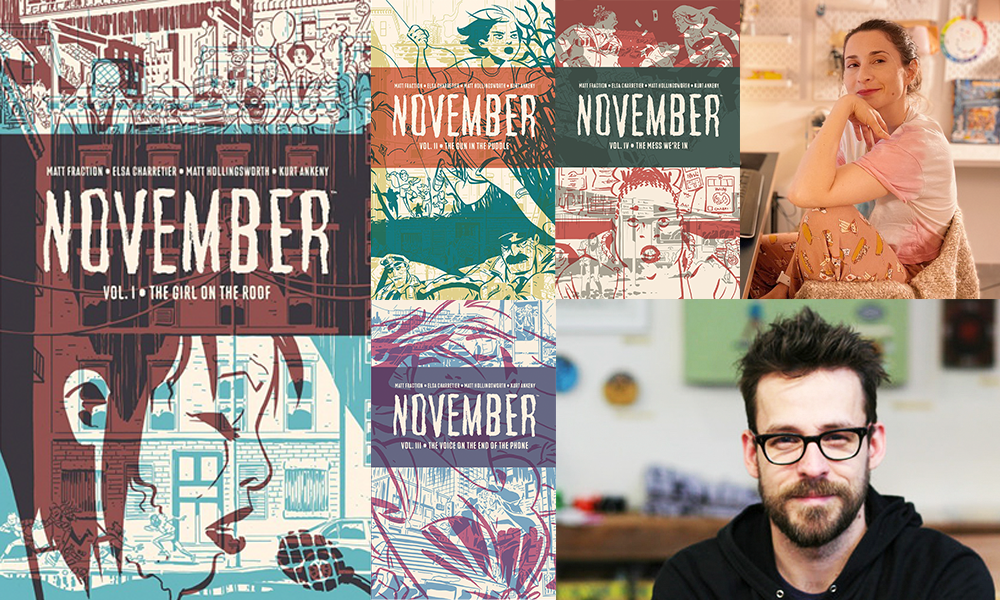Matt Fraction, November, and Formalist Comics Storytelling

Portland’s sweetheart Matt Fraction writes comics. From a super-spy gorilla (Rex Mantooth), to a time-hopping human super-spy (Casanova), to a neo-Western homage to Charley Varrick complete with the name of the eponymous film character’s sham repair company Last of the Independents, to writing the adventures of Thor and Iron Man just as the 2008 blockbuster-come-cinematic-universe-starter dropped, Matt Fraction’s career has been, to pardon a pun, storied. Hawkeye debuted on the New York Times best seller list, blowing expectations for a solo series about the Earth’s least super-powered Avenger out of the water. Sex Criminals, the story of a couple who discover they both stop time when they orgasm and decide to rob banks, sent its first issue to six printings and found a community of devoted readers who not only share their experiences finding pornography in the woods in the letter columns, they turn up for warehouse parties where artist Chip Zdarsky dresses as Garfield, and the scribe himself submits to a live nipple piercing. Little Fraction has done before, however, prefigures the experiment which is November.
All four hardcover “issues” have now dropped, detailing apocalyptic conspiracy, the travails of three women connected by threads on a narrative evidence board, and the mystery of an abandoned gun in a puddle. The fourth, which just came out on February 24, 2021, completes the tetralogy, but the legacy of these hardcover experiments in longer-form, serialized storytelling may well ripple through the comics industry for years to come.
Fraction borrowed the strategy from a successful team of Ed Brubaker and Sean Phillips, but where they decided to experiment with dropping the latest story in their long-going anthology Criminal, with My Heroes Have Always Been Junkies, Fraction and his collaborators Elsa Charretier (self taught artist extraordinaire); Matt Hollingsworth, frequent collaborator and colourist for Hawkeye; and cartoonist Kurt Ankeny (on lovely letters, indeed) have taken the gambit a step further. Average sales of twenty-to-thirty-page “floppies” have steadily declined (barring variants and spectator purchasing) since the late 1950s, owing to the institution of the Comics Code which effectively removed comics from newsstands and drugstore spinner racks. As a result, the comics market has become increasingly reliant on trade paperback and bookstore sales (narrative units of greater substance, with graphic novel collections of serialized stories collecting four or more single issues.
But many books never complete their arcs or even have a chance to reach the audiences who engage in so-called “trade waiting” because single issue attrition remains the benchmark for industry investment in a given project, regardless of its bookstore market afterlife. For notable examples, look no further than Fraction’s Hawkeye. The prestige of square bound, even hardcover volumes adorning shelves without first testing the waters with single issues has long been anathema to the industry’s inertia despite the tradition of hardcover “albums” in French and other European comics markets. Fraction uses the real estate to his advantage, however, capitalizing on the demands of the binge audience with time-released morsels of greater substance and heft than even the overpriced cardstock variant covers, which Marvel and DC use to steadily increase the issue prices of to five, even six dollars a pop.
Each volume (thus far) has been broken into chapters, color coded to each of the three protagonists and with a prologue and epilogue featuring the key protagonist of the volume, one set each, for the three protagonists. Within pages, Fraction and Charretier exemplify the impact of both “compressed” and “decompressed” storytelling, referring to the proliferation of panels depicting actions—the more panels devoted to each action, the more decompressed the storytelling. Readers interested in the form of comics storytelling would do well to pick up November, both for its tense story and the sublime craft on display. For a writer like Fraction whose timelines are seldom linear and who penned an Eisner-winning issue of Hawkeye drawn and coloured from the perspective of the book’s canine lead, Lucky, November is another experiment in expanding the medium—both on the page and on the shelves.
Fraction is no stranger to changes in the market, having, like his mentor and writing partner on The Immortal Iron Fist, Ed Brubaker, successfully parlayed a Big Two readership into an audience for more personal and independent projects at Image. These include Casanova, Satellite Sam, a 1950s period piece about the golden age of television plays, and a genderbent space-bound Odyssey called ODY-C. Where others continue to ply their trade in twenty-two-page increments, however, Fraction and company may well lead the charge for a sea-change in the industry, a change which, hopefully rather than supplanting the single issue as the storytelling unit, will merely challenge its hegemony.
Check out November volumes one, two, three, and four, and be sure to order through your local shop. Some of Portland’s fabulous shops are listed and linked below.
Books With Pictures — East Portland
Bridge City Comics — North Portland
Cosmic Monkey Comics — Northeast Portland
Excalibur Comics — East Portland
Floating World Comics — Downtown Portland
Other Worlds Games and Comics — Southwest Portland
Things From Another World — Beaverton/Downtown Portland/Milwaukie
0 Comments